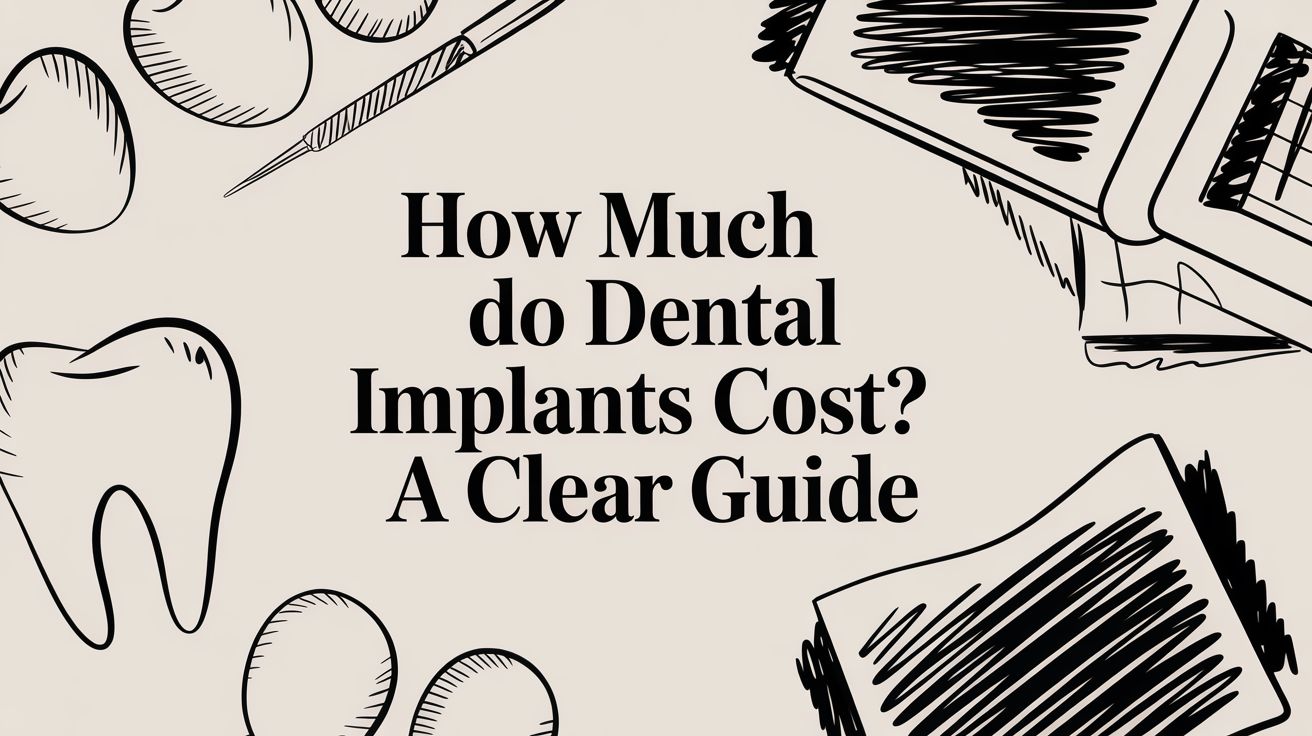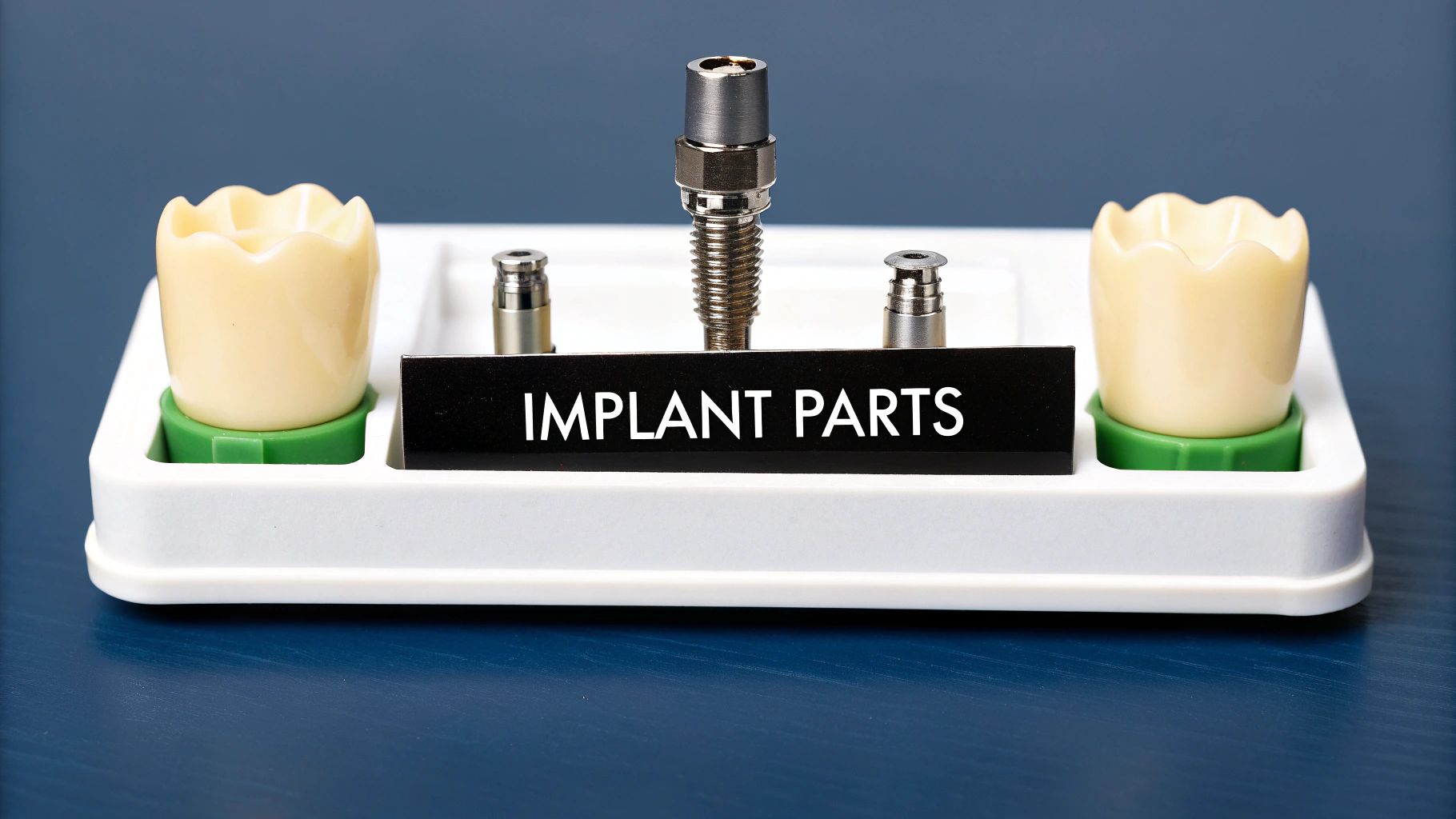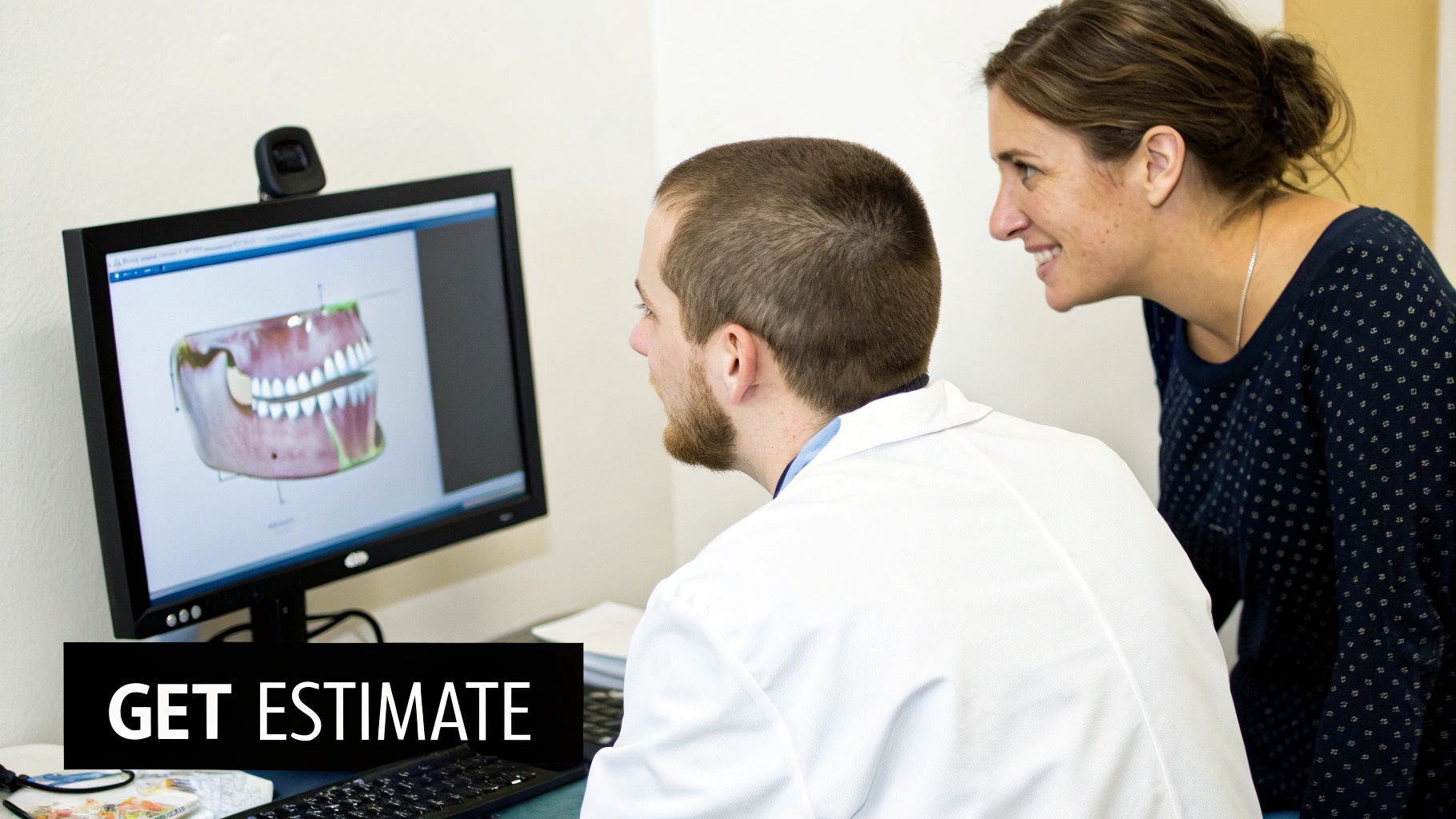
A single dental implant, including the post, abutment, and final crown, typically costs between $3,000 and $5,000. This is a comprehensive estimate for restoring one tooth. However, your final cost will depend on several factors, including your specific oral health needs, geographic location, and the materials used for the procedure. Think of this range as the all-in investment to rebuild a single tooth from the root up.
When you ask, "how much do dental implants cost," you need a reliable number to set your expectations. While every patient's treatment plan is unique, understanding the typical price range is an essential first step. Dental implants are a permanent investment in your health and confidence, and knowing the baseline helps you plan for this important procedure.

The total price covers three critical components—the implant post, the abutment, and the crown—plus the surgical expertise required for precise placement. Each part plays a specific role in creating a functional, natural-looking tooth that is designed to last a lifetime.
To understand where your investment goes, it’s helpful to break down the implant process into its individual components. The total cost covers the surgical placement, the high-quality materials, and the custom-crafted tooth that completes your smile.
This table provides a clear snapshot of the average national costs for each major component of a standard, single-implant procedure.
| Component or Service | Average National Cost Range |
|---|---|
| Dental Implant Post (Titanium Screw) | $1,600 – $2,200 |
| Abutment (Connector Piece) | $900 – $1,300 |
| Dental Crown (Visible Tooth) | $1,000 – $2,000 |
| Total Estimated Cost (Single Implant) | $3,500 – $5,500 |
It's important to note that these are average figures. Additional procedures, such as 3D diagnostic imaging, a necessary tooth extraction, or bone grafting to ensure a solid foundation, are quoted separately based on your specific oral health needs.
Dental care costs can vary significantly based on location. Nationally, the average cost for one dental implant typically falls between $3,000 and $5,000.
You can learn more about the cost breakdown of dental implants from industry experts to see how these numbers compare.
The key takeaway is that an implant is a comprehensive solution. The price reflects advanced materials, surgical precision, and a customized restoration designed for longevity. The initial number is just the beginning of the story.
The cost of a dental implant reflects a sophisticated, multi-part system designed to permanently restore your tooth from the root up, not just a single product. It’s an investment in advanced materials, expert craftsmanship, and the precise planning required for a successful, long-lasting result.

Understanding the function of each component and the critical role of diagnostics makes the overall cost much clearer. The total price covers three core parts that work in synergy, plus the meticulous planning that ensures the system functions flawlessly for decades. Let's examine exactly where your investment goes.
The effectiveness of a dental implant lies in its three-part structure. Each piece is engineered from biocompatible materials that your body accepts, allowing for a stable, functional, and natural-looking new tooth.
Here are the essential building blocks of your new smile:
The Titanium Implant Post: This is the foundation of the restoration. It’s a small, screw-like post made of medical-grade titanium that is surgically placed into your jawbone to act as a synthetic tooth root. Its purpose is to fuse directly with the bone in a process called osseointegration, creating an incredibly strong and stable anchor. This fusion is what makes implants so durable and prevents the bone loss that occurs when a tooth is missing.
The Abutment: The abutment is the connector piece. It attaches securely to the top of the implant post, sitting just above the gumline, and provides a solid base for the final crown. Custom-made abutments are used to ensure a perfect fit and a natural transition from the gum to the tooth.
The Custom-Crafted Crown: This is the visible, tooth-shaped cap that attaches to the abutment. Unlike a generic solution, this crown is custom-designed in a dental lab to match the exact color, shape, and size of your natural teeth. It's typically made from high-quality porcelain or zirconia, materials known for their strength and lifelike appearance. This component is what allows you to chew, speak, and smile with complete confidence.
Before the implant is placed, a critical diagnostic step occurs: advanced imaging. This involves a detailed mapping of your oral anatomy using state-of-the-art 3D cone-beam computed tomography (CBCT) imaging.
A CBCT scan provides a detailed, three-dimensional view of your jawbone, nerves, and sinuses. This level of precision planning is non-negotiable for a successful outcome, allowing us to place the implant in the ideal position for maximum stability and safety.
This diagnostic phase is an essential part of the investment. It minimizes risks, prevents surprises during surgery, and ensures the final result is perfectly aligned and functional. Skipping this step to cut costs would be like building a custom home without a blueprint—it’s a recipe for long-term problems. By investing in this technology upfront, we ensure your implant has the best possible chance of lasting a lifetime.
Asking "how much do dental implants cost" is similar to asking how much a home renovation costs. There is no single price because the final investment depends on the specifics of your oral health. Several critical factors will shape the final cost of your new smile.
Understanding these variables makes it clear why a one-on-one consultation is the only way to get a truly accurate quote. It’s about tailoring the solution to ensure a successful, lifelong outcome.
The most straightforward factor is volume. Replacing a single missing tooth with one implant is the baseline scenario. If you are missing several teeth in a row or an entire arch, the complexity and material costs increase.
However, you don't always need one implant for every missing tooth. For instance, two implants can often support a dental bridge to replace three or four missing teeth, providing a stable and efficient solution. For a full arch replacement, a treatment like All-on-4® uses a strategic number of implants to support a complete set of new teeth.
This is perhaps the biggest variable affecting your final cost. A successful dental implant requires a strong, healthy foundation of jawbone to fuse with through osseointegration. If a tooth has been missing for an extended period, the jawbone in that area naturally begins to shrink due to lack of stimulation.
Preparatory procedures are essential if your bone density is insufficient. We cannot simply place an implant and hope for the best; building up the foundation first is non-negotiable for long-term success.
This may mean you need additional treatments before implant surgery can begin:
Bone Graft: This procedure adds bone material (from your own body, a donor, or synthetic sources) to the jaw to increase its height and width. This creates the solid, dense base the implant needs to integrate properly.
Sinus Lift: When replacing upper back teeth, the sinus cavity may be too close to the jawbone. A sinus lift gently raises the sinus floor and places a bone graft underneath, creating enough vertical space for the implant post.
These procedures are crucial for many patients and add to the overall cost and timeline, but they are a vital investment in the longevity of your implant.
The materials used for implants and crowns also influence the cost. The two main materials for implant posts are titanium and zirconia. Titanium is the industry standard, known for its strength and biocompatibility. Zirconia is a ceramic, tooth-colored alternative that is an excellent option for its aesthetic qualities, especially for patients with metal allergies. Your choice of material can alter the final price.
Geographic location also plays a role. The global dental implant market is projected to reach approximately $13 billion by 2032, driven by an aging population and growing demand. Costs often reflect local economic factors, with urban centers typically having higher overhead than smaller towns. A specialist's expertise also commands a higher fee than a general practitioner, reflecting their advanced training. You can explore more about dental implant market trends and statistics on schwimmerdental.com.
The initial cost of a dental implant can be significant, especially when compared to the lower upfront cost of options like bridges or traditional dentures. However, the true value of an implant becomes clear when you consider the total cost over 10, 20, or even 30 years.
An implant is designed to be a permanent, one-time solution. In contrast, alternatives often require a cycle of replacements, repairs, and adjustments that add up over a lifetime, making them more costly in the long run.
A dental bridge may seem more budget-friendly initially but typically lasts only 10 to 15 years. This means you are almost guaranteed to pay for a full replacement at least once, and possibly twice, during the lifespan of a single dental implant. Each replacement involves new material and labor costs.
Traditional dentures have a similar pattern of recurring expenses. They require professional relining every few years to maintain a proper fit as your jawbone changes. Furthermore, the dentures themselves usually need to be completely replaced every 5 to 8 years. These ongoing costs can make dentures the more expensive option over time.
Perhaps the biggest long-term cost of a bridge isn't financial, but biological. To anchor a bridge, the healthy, natural teeth on either side of the gap have to be permanently filed down. This procedure weakens those teeth, leaving them vulnerable to future decay and other problems, which can lead to even more extensive—and expensive—dental work down the line.
This infographic breaks down how different factors—like the number of teeth being replaced, material choices, and current oral health—all contribute to the final cost of an implant.

As the infographic illustrates, your final investment is directly tied to the unique requirements of your treatment plan.
To visualize the difference, consider a 30-year timeline. A dental implant is a standalone fixture that helps preserve your jawbone and does not stress neighboring teeth. In many cases, the final crown can be made and placed in a single appointment. Learn more about this process in our guide to what are same day dental crowns.
This table provides a clear comparison of the long-term value of the most common tooth replacement options.
A side-by-side look at the initial cost, lifespan, maintenance, and overall value of different tooth replacement options reveals a lot about the true long-term investment.
| Feature | Dental Implants | Dental Bridge | Traditional Dentures |
|---|---|---|---|
| Initial Cost | Higher | Moderate | Lower |
| Average Lifespan | 25+ Years (Potentially Lifetime) | 10-15 Years | 5-8 Years |
| Replacement Costs | Minimal to none (crown may need replacing) | 1-2+ Replacements Expected | 3-5+ Replacements Expected |
| Maintenance Needs | Normal brushing and flossing | Special cleaning tools needed; risk to anchor teeth | Daily removal, cleaning, adhesives, and relining |
| Impact on Jawbone | Stimulates and preserves bone | Does not prevent bone loss under the gap | Accelerates bone loss due to lack of stimulation |
| Overall 30-Year Cost | Often the most cost-effective option | High due to multiple replacements | High due to frequent replacements and adjustments |
While the initial investment for a dental implant is higher, the long-term financial analysis often shows it to be the most prudent choice. You pay once for a permanent solution that actively protects your oral health, rather than repeatedly paying for temporary fixes that can introduce new complications and costs.
Understanding the value of a dental implant is the first step; the next is figuring out how to fit it into your budget. There are several practical ways to make this investment in your oral health more manageable.
From utilizing dental insurance benefits to exploring flexible payment plans, you have several options to control the cost. Our goal is to provide the information you need to navigate these financial solutions confidently.
While not all dental insurance plans cover the full cost of implants, many are beginning to offer partial coverage as they recognize implants as the standard of care. It's rare for a plan to cover the entire procedure, but it can significantly reduce your out-of-pocket expenses.
Here’s how insurance can typically help:
Covering Related Procedures: Your plan might not pay for the implant post itself but may cover a portion of the final crown or other necessary steps like a tooth extraction.
Annual Maximums: Most insurance plans have a yearly maximum benefit, often around $1,500 to $2,000, which you can typically apply toward your implant treatment.
The most effective first step is to have our team request a pre-treatment estimate. We will submit your treatment plan to your insurance provider to get a clear breakdown of what they will cover, so there are no surprises.
Third-party financing is a popular and effective way to manage the remaining balance. These services allow you to break down the total cost into predictable monthly payments that fit your budget, often with low-interest or even 0% interest plans available.
This approach is similar to financing a car or home renovation. You get the immediate benefit of your new smile while spreading the investment over a comfortable period, putting you in control of your finances.
We partner with leading financing companies to provide flexible solutions:
CareCredit: A well-known option offering a variety of short-term and long-term payment plans for healthcare expenses.
Cherry: Another patient-friendly financing service that provides simple, transparent payment plans with clear terms.
At Clayton Dental Studio, we are committed to making exceptional dental care accessible. For patients without insurance, our Humble Savings Plan is an excellent alternative, offering significant discounts on many treatments, including restorative procedures like implants.
We also run promotions to help new patients begin their journey toward better oral health. To see what current offers could help with your implant costs, check our new patient specials. By combining insurance benefits, financing, and our in-house plans, you can build a financial strategy that makes your ideal smile a reality.
After reviewing the components, cost factors, and financing options, the next step is to move from national averages to a personalized quote. The only way to truly answer "how much will my dental implants cost?" is with a one-on-one consultation where we create a clear plan for restoring your smile.
This process is similar to getting a quote from a craftsman before they build custom furniture; they need to see the space and take precise measurements. Likewise, we need to evaluate your unique oral anatomy to create a plan that ensures a successful, long-lasting result.

Your first visit is a comprehensive diagnostic appointment designed to provide a complete picture of your oral health. This is a no-pressure opportunity for you to ask questions while we gather all necessary information.
The process is straightforward and focused on precision:
Comprehensive Dental Exam: We begin with a thorough evaluation of your teeth, gums, and overall oral health to identify any underlying issues that need to be addressed.
Advanced 3D Imaging: We use a state-of-the-art cone-beam computed tomography (CBCT) scanner. This technology provides a detailed 3D image of your jawbone, allowing us to see its exact density, height, and width, as well as the precise location of nerves and sinuses.
Personalized Treatment Planning: With this data, Dr. Kamboj can determine if you need preliminary work, like a bone graft, and map out the ideal placement for your implant to ensure maximum stability and safety.
This meticulous planning is the key to a predictable and successful outcome. By using advanced imaging, we eliminate guesswork and ensure your treatment is tailored perfectly to your anatomy.
Following your exam and scan, we will review our findings with you. You will receive a fully transparent, line-item cost breakdown that details every step of your recommended treatment plan, with no surprises or hidden fees. You will see exactly what each component and procedure costs, from the implant post to the final custom-made crown.
This level of detail empowers you to make an informed decision with total confidence. Precision planning is crucial for long-term success. While 93% of U.S. implant cases use biocompatible titanium, their success hinges on expert placement. Our detailed approach helps ensure our procedures align with high prosthetic survival rates, such as the 98.8% success of All-On-4 procedures. You can learn more about dental implant success rates and statistics on impressionsdental.com.
Your smile is a lifelong investment. The first step is getting a clear, accurate picture of what it will take to reach your goals. Contact Clayton Dental Studio today to schedule your consultation and receive your personalized estimate.
It's normal to have more questions about the cost of dental implants. Getting clear, straightforward answers is essential for feeling confident about your decision. Here are some of the most common questions we hear from our patients.
The answer depends on your specific plan. While many basic insurance plans historically considered implants a cosmetic procedure, this is changing. More comprehensive dental policies now offer partial coverage, recognizing implants as the best long-term solution for missing teeth.
Often, a plan will cover specific parts of the process, such as the final crown or a related tooth extraction, rather than the entire procedure. The only way to know for sure is to have our team request a pre-treatment estimate from your insurance provider. This document will provide an exact breakdown of what your policy will contribute.
While the temptation to save money is understandable, extremely low-cost implants should be approached with caution. A price that seems too good to be true often indicates a compromise in quality, materials, or expertise.
Investing in a high-quality, expertly placed dental implant is an investment in your long-term health. Prioritizing quality over a low upfront price is crucial for avoiding complications and ensuring a result that lasts a lifetime.
A suspiciously low price could mean the dentist is using substandard materials, outdated techniques, or lacks experience. These factors can increase the risk of complications, from infections to complete implant failure. Correcting a failed implant is always more expensive and complex than ensuring it is done right the first time.
Be cautious of advertisements promoting unbelievably low prices. A common marketing tactic is to quote only the price for the implant post itself, which is just one piece of the puzzle. This creates a misleading picture of the final cost.
That initial "low-ball" quote almost always excludes mandatory costs such as:
The surgical placement fee
The custom abutment (connector piece)
The final, permanent crown
Essential diagnostics like the 3D scan
At Clayton Dental Studio, we believe in complete transparency. We provide a single, comprehensive estimate that covers every step of your treatment. This way, you understand the full cost from day one and can plan accordingly without hidden fees or last-minute surprises.
Ready to take the next step toward a permanent, confident smile? The team at Clayton Dental Studio is here to provide a clear, personalized cost estimate and answer all your questions. Schedule your no-pressure consultation today to determine the best path forward for your oral health. Visit us at https://www.claytondentalstudio.com to book your appointment.
Article created using Outrank